
‘’Happy Birthday Miss Jones’’
1) Introduce the picture
This document is an oil painting by Norman Rockwell entitled ‘’ Happy Birthday Miss Jones’’. It was painted in 1956 by Norman Rockwell. This painting appeared on the cover of the Saturday Evening post published on March , 1956. The original oil painting belongs to film maker : George Lucas.
2) The topic
This painting represents a perfect 50s american classroom . The pupils wrote messages for their teacher’s birthday on the blackboard. It’s a surprise for their teacher.
3) Describe the picture
This oil painting is divided into 3 parts :
– In the foureground we can see the pupils
– In the middle ground we can see the desk with the presents
– In the background we can see the teacher and the blackboard
The scene takes place in an american classroom with pupils sitting patiently in front of their teacher. The teacher has just arrived, she is holding her hat and her coat. She is looking at her pupils with a little kind smile : she has discovered the blackboard with birthday wishes. The teacher and pupils are nice and properly dressed. On the wooden desk, there are some presents for the teacher : orange, apple, flowers and paquetages. One of the children have a blackboard eraser on the top of his head, an other eraser and a chalk are on the floor in front of the teacher. On the left of painting, we can see a piece of American flag.
We can remark that all the children look at their teacher and teacher looks at her pupils, they look at each others, and these regards draw a triangle in the painting. The others lines in the painting, are horizontal and vertical (blackboard and wall).
4)Analyze and interpret
We can easily imagine that Norman Rockwell wanted to paint a lovely and ideal classroom with cute pupils and a kind and respectable teacher. There is a lot of tenderness in this scene. The teacher sems so tall, it’s because she’s the main character in this oil painting.
I’m surprised to see only white people on this oil painting. During the fifties, there was racism in America, so this painting shows us the segregation : black children didn’t go to school with white children. White people were considered superior race. The flag shows the American patriotism during the cold wear.
5) My feelings
I think this painting represents very well the american school during the fifties : white pupils with a lovely female teacher. I think it’s a stereotyp image of an ideal school. We can oppose this oil painting with an other painting : ‘’The problem we all live with’’.
In the second oil painting, going to school is a real problem because the little girl is black.











